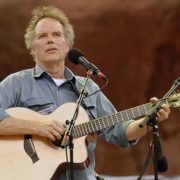LEO KOTTKE IN CONCERT
LEO KOTTKE IN CONCERT
SMOTHERS THEATRE AT THE LISA SMITH WENGLER CENTER FOR THE ARTS (PEPPERDINE UNIVERSITY) – OCTOBER 10, 2019~8:00pm
ROCK ON TOUR
 “The single greatest influence on finger-style guitarists…It’s the cat’s pajamas.” –Don Ross
“The single greatest influence on finger-style guitarists…It’s the cat’s pajamas.” –Don Ross
Raconteur extraordinaire and finger-style guitarist par excellence Leo Kottke held forth for an hour and a half last night, dazzling his enthralled listeners with stories and songs and instrumentals on six and 12-string acoustic guitars. In between he told amazing tales of the late great Leon Redbone and the hole in his trombone case, the cartoonist’s worst nightmare Flattop and propane tanks, the siege of Vicksburg, his third grade teacher, and his uncle Irv Funk. You never knew where he was going next, with his guitars or his storytelling, but you always seemed to wind up in the right place. It was an intense, extraordinary evening, that led inexorably to his gorgeous last song, Corrina, Corrina, played on his six-string Taylor guitar, tuned down two steps to some inventive open tuning known only to Kottke. The bravos and standing ovation said all that needed to be said.
Kottke was born in Athens, Georgia, on September 11, 1945 and raised in 12 different states, one for every string on his 12-string guitar, the one he recorded his first album on in 1969, which he sent to John Fahey—who fell in love with it and signed him to his own label—Takoma Records. He released his second album—6 and 12—String Guitars on Takoma. Since then he has released 22 albums in various combinations of solo and duo arrangements.
His trailblazing syncopated finger-style guitar picking has seen some necessary adjustments over the years, due to tendonitis from the stress upon his hands caused by his intense, muscular picking. He finally gave up picks altogether and relearned the instrument with just the tips of his fingers. But he still plays with a sense of propulsion and polyphonic countermelodies that hold his enrapt audience in the palms of his hands. There is simply nobody like him, or even close. And yet, so fluid is his playing that you don’t appreciate the complexity of his rhythms unless you watch as closely as you listen.
As Yeats once said of the poet’s art, the aim is to make it all seem effortless, to conceal the effort behind it. Kottke pulls it off, in every note and grace note.
The Essential Leo Kottke is the double album from 1991, which may surprise some listeners with the familiarity of its tunes. What I discovered was the supreme delight of seeing Kottke’s guitar wrapped around such familiar songs as Bob Nolan’s Tumbling Tumbleweeds, the Everly Brothers All I Have to Do is Dream, and most surprisingly Kris Kristofferson’s Here Comes That Rainbow Again, written from a scene in The Grapes of Wrath, which I had only heard live by Kristofferson and recorded by Johnny Cash. You suddenly realize that Kottke is unafraid of great melodies, and goes constantly in search of them. It isn’t just countermelodies that captivate his guitarist’s fancy, but the innate power of a melody as well. You can’t have one, he makes me realize, without the other. In the end, that’s why I love his playing, and have stayed true to his muse all these years. Leo Kottke is a guitarist’s guitarist, one who opens up the fret board to all manner of virtuoso invention, without losing sight of his original purpose in creating a world of beautiful sound.
Even more surprising is the final song on his most recent studio album Try and Stop Me, from 2004—The Banks of Marble. That’s a classic protest song by Les Rice, popularized by Pete Seeger on the banjo. Dare I say it? I sing it in Pete’s style on my banjo. To hear Kottke play it on guitar is a revelation—like hearing a new song altogether. I realize why the song appeals to me—it’s not the lyrics so much as the underlying melody, which I had all but ignored until I heard Kottke’s version. This is my candidate for Kottke’s Gatekeepers of Freedom 2019 moment,
But now to the weirdly beautiful tales that intertwine around Kottke’s music~ don’t waste your time trying to understand Kottke’s strange stories of Chester Gould’s fictional villain Flattop—the most popular character ever created for Dick Tracy. Just accept it as inevitable, and enjoy the ride. He keeps you guessing, just like his guitar wizardry, and as you bounce from one to the other, you can’t help but marvel at the Marvel Strips that hold his act together. Before you know it you are in another world, where his guitar has taken you on a wild trip. It may not seem like a journey so much as a merry-go-round or carousel. And then, just as suddenly, you are transported to another dimension with reference to the Twilight Zone, which I wrote about previously in a review of his 2015 concert.
One of those other dimensions takes you to Morris, Minnesota, where Kottke is trying to write a song for his daughter. It’s not going well, so he enlists the help of a co-writer Al Gaylor, who resists his efforts until Kottke prevails upon him to try. Gaylor finally comes up with an idea that bends the song in a new direction—and instead of just restricting the song to a moving but boring cradle, adds “From the cradle to the grave”~ which brings it to life—or death. Suddenly the song works.
Kottke enjoys singing it.
Still another song he wrote about a “very unfulfilling canoe trip.” And slowly he veers off in a new direction, about the time he broke a string, and then found a hole in the bottom of his trombone case—somehow it reminds him of a small whistle, and that leads him to a strange convergence which results in a classic song by Duane Allman—his way of remembering the dearly departed “forevermore”—as he had done for Leon Redbone earlier in the show—once again “from the cradle to the grave” which it turns out is a favorite theme of his.
And this he announces (after he has done it) will be the last song of the night. Except for the encore, so “we can all leave the building together.” Then he leaves us with his glorious guitar version of Corrina, Corrina—which another Minnesotan (Bob Dylan) did on the Freewheelin’ Bob Dylan album.
I got a bird that whistles
I got a bird that sings
But if I ain’t a got Corinna
Life don’t mean a thing.
Leo Kottke also lost part of his hearing in his left ear from a misplaced firecracker, and partly the right ear too, from firing practice—when he was in the Navy. His challenges in continuing to play music were of the most extreme kind. But as his most recent record indicates, Try and Stop Me—nobody could.
“Geese farts on a muggy day” is Kottke’s description of his singing style, which explains why he prefers to play instrumental pieces. This led to his solo album One Guitar, No Vocals, in 1999. And yet he himself was influenced by no less an artist than Mississippi John Hurt, from whom he picked up his first syncopated style of guitar. Hurt was a master vocalist as well.
So Kottke opens his show, as he always does, by singing Pamela Brown, his forlorn tale of lost love. Here it is, written by Tom T. Hall and recorded on Kottke’s Ice Water, in 1974:
I’m the guy who didn’t marry pretty Pamela Brown
Educated, well-intentioned good girl in our town
I wonder where I’d be today if she had loved me too
Probably be driving kids to school
I guess I owe it all to Pamela Brown
All of my good times, all my roamin’ around
One of these days I might be in your town
And I guess I owe it all to Pamela Brown…
I don’t have to tell you just how beautiful she was
Everything it takes to get a guy like me in love
Lord, I hope she’s happy ’cause she sure deserves to be
Especially for what she did for me.
She’s Jimmy Durante’s Mrs. Calabash. Durante dedicated every performance to her, “Wherever you are.” That’s why Kottke can do a song he didn’t have to write. As he travels around the country on his Rock On Tour, this raconteur may find her. Or he may not. It’s all the same to him. With thanks to Tyler Flynn for the press passes, and my guest recording engineer Scott Fraser, who first saw Leo Kottke in 1972, when he was performing with Procol Harem in Portland. Kottke was carrying three guitar cases, and looking for the venue. Scott didn’t realize who he was, until he saw him on stage.
Ross Altman has a PhD in Modern Literature from SUNY-Binghamton (1973); he belongs to Local 47 (AFM), and serves as president of the Santa Monica Traditional Folk Music Club; he writes for www.folkworks.org and may be reached at greygoosemusic@aol.com













